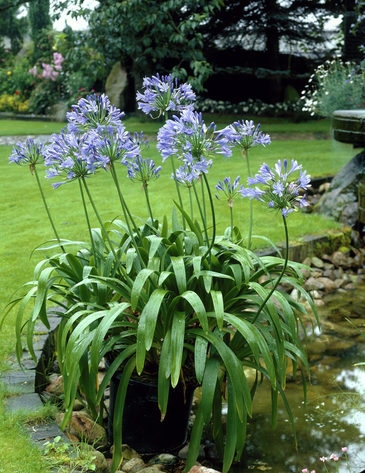Agapanthus Proliferation: Tips for Expanding Your Plant Collection
Agapanthus Proliferation: Tips for Expanding Your Plant Collection
Blog Article
Mastering the Art of Agapanthus Treatment: Important Steps for Healthy And Balanced Development and Vibrant Flowers
In the world of gardening, the growing of agapanthus stands as a gratifying endeavor for those that look for to support these stylish flowering plants. From selecting the best range to grasping pruning strategies, the journey in the direction of cultivating flourishing agapanthus plants is diverse and holds the vital to opening the complete potential of these organic gems.

Selecting the Right Agapanthus Selection

When picking the right Agapanthus selection for your garden, think about elements such as climate viability, bloom shade, and growth routine. Furthermore, take into consideration the climate in your area to make sure the Agapanthus selection you choose can grow in your certain conditions. Understanding the development practice of various Agapanthus selections is critical for correct positioning within your yard.
Perfect Planting Conditions
Taking into consideration the optimum environmental demands is crucial for effective Agapanthus farming. Agapanthus prospers in well-draining dirt with a slightly acidic to neutral pH level. When planting, select a place that receives full sunlight to partial shade. In hotter environments, offering some afternoon color can stop scorching of the leaves. Agapanthus plants are sensitive to cold temperatures and should be shielded from frost throughout winter season months.
To ensure healthy and balanced growth and lively blossoms, plant Agapanthus light bulbs at a deepness of regarding 2-4 inches and area them 8-12 inches apart. Including raw material, such as compost, to the soil can enhance drainage and fertility, advertising robust root growth. Mulching around the base of the plants assists preserve dampness and reduces weed development. Routine watering is important, particularly during the expanding period, to maintain the soil continually moist yet not saturated.
Watering and Fertilizing Tips
Preserving proper dampness levels and offering important nutrients are crucial elements in the care routine for Agapanthus plants. It is crucial to strike an equilibrium when it comes to sprinkling Agapanthus. These plants prefer continually moist soil however are vulnerable to root rot if overwatered. During the expanding season, water deeply once a week, making certain the soil is well-draining to stop waterlogging. In hotter climates or during durations of dry spell, even more frequent watering might be required to maintain the dirt equally moist. Nevertheless, minimize watering in the winter months to avoid waterlogged problems.
Feeding Agapanthus is important for advertising healthy and balanced growth and prolific blooms. Use a balanced plant food, such as a 10-10-10 formula, in the More hints early spring as brand-new development emerges. By complying with these watering and feeding ideas, you can ensure your Agapanthus plants flourish and produce vivid, lasting blossoms.
Trimming Techniques for Agapanthus
Trimming Agapanthus plants at the proper times and with appropriate strategies is essential for keeping their health and advertising ideal development and blooming. The perfect time to prune Agapanthus is in late winter or very early spring before new development arises.
For flowered stems, wait till the blossoms have withered and after that trim them back to the base. This not just tidies up the plant's appearance but likewise encourages the development of new flower buds. Deadheading spent blossoms can also redirect the plant's energy into creating even more flowers instead than establishing seeds. link Nevertheless, if you intend to collect seeds for propagation, leave some flowers to completely dry and mature on the plant.
Remember to make use of tidy, sharp devices to make exact cuts and reduce the threat of presenting diseases. Agapanthus. Regular pruning will certainly help keep your Agapanthus looking healthy visit homepage and balanced and neat while guaranteeing a plentiful display of gorgeous flowers
Managing Usual Insects and Conditions
After making certain appropriate pruning methods for Agapanthus, it is important to attend to usual bugs and conditions that can affect the wellness and vigor of these plants. Agapanthus plants are normally sturdy however can still drop victim to specific concerns. One usual bug that affects Agapanthus is the Agapanthus gall midge. This small, orange fly lays its eggs in the vegetation, resulting in distorted development and blossom buds that stop working to open. To battle this insect, trim and damage any damaged plant parts and consider making use of insecticidal soap.
An additional typical concern is fungal leaf area, which offers as dark sores on the fallen leaves. To avoid fungal illness, ensure good air circulation around the plants, avoid above watering, and remove any kind of infected leaves quickly. In addition, Agapanthus plants can experience root rot if they are planted in badly draining pipes soil. To prevent this, plant Agapanthus in well-draining soil and stay clear of overwatering. By being watchful and taking prompt action against pests and conditions, you can help your Agapanthus plants grow and generate vivid blooms.

Final Thought
Finally, grasping the art of agapanthus care involves choosing the best selection, providing suitable growing conditions, proper watering and feeding, appropriate trimming methods, and addressing usual pests and conditions. By complying with these essential steps, you can make certain healthy growth and dynamic flowers for your agapanthus plants. Remember to consistently keep track of and preserve your plants to promote their overall wellness and durability.
To guarantee healthy and balanced development and lively blossoms, plant Agapanthus bulbs at a deepness of regarding 2-4 inches and area them 8-12 inches apart. By complying with these watering and feeding ideas, you can guarantee your Agapanthus plants flourish and create vivid, lasting blooms.
One usual insect that affects Agapanthus is the Agapanthus gall midge. Furthermore, Agapanthus plants can suffer from root rot if they are planted in badly draining pipes dirt. By adhering to these important steps, you can ensure healthy growth and lively blooms for your agapanthus plants.
Report this page